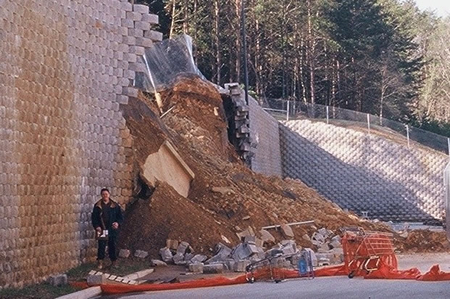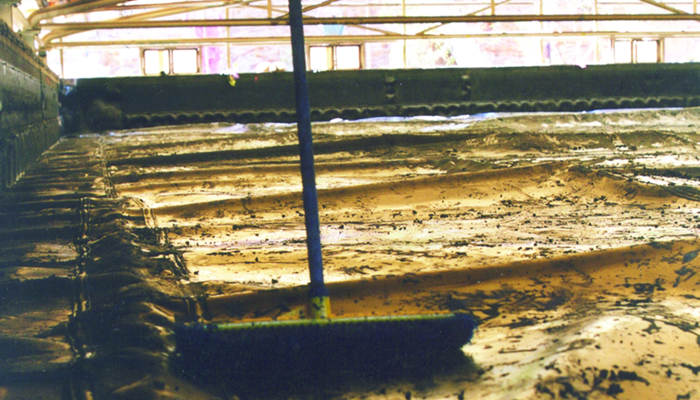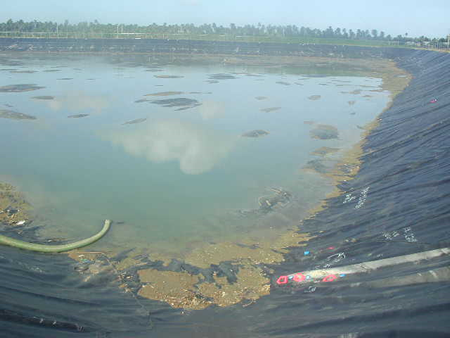In 2003, Geosynthetica and Dr. Ian Peggs of I-CORP International began to agitate for the creation of an industry-wide movement on risk management in geosynthetic projects. The initial efforts were launched with a column in GFR magazine (now Geosynthetics). By early 2004, a white paper was drafted to support the creation of the Geosynthetics Risk Management Program. Admittedly, the acronym GRMP was a bit … grumpy sounding. But the focus of the program was highly valuable and, arguably, exists today in various forms.
Ultimately, GRMP was about safety. It was about reputation. It was about loss control.
The architects of the plan, Ian Peggs, Lara Costa, and Elizabeth Peggs, analyzed numerous failures in the field and found that more than 95% of the cases they reviewed were preventable, largely through very simple and very affordable means.
The risk management program they designed would identify critical control points at which risk could be managed, after which measures would be established by which one could best manage those risks. These weren’t boutique solutions either. The most common strategies they promoted were peer-reviewed design and the use of certified geosynthetics installation crews.
They promoted deference to expertise.
These measures were the difference between success and failure. It was, as they wrote in 2004, “the difference between a million dollar project or a multi-million dollar insurance pay-out.”
RELATED: Four Failures That Still Tell the Right Story
FOCUS ON INSURANCE RISK MANAGEMENT
One of the unique approaches the team took was to target insurers of construction projects, rather than placing the weight of the risk management argument on the geosynthetics industry. They saw it as somewhat similar to how geosynthetics became standardized in municipal solid waste designs. That was not just industry. That movement required independent professionals and many regulators weighing in. In waste management, it had an immense and highly beneficial impact for society and for the field of geosynthetics.
(MSW regulation with geosynthetics also led to a sea change in how coal ash is handled in the United States–though only after a couple significant failures made the need for controls clear in both public and regulatory debates.)

The same strong results were sought with how projects using geosynthetics are insured. Requiring expert review and top-tier installation practices would be highly beneficial. And simple review, they argued, could prevent costly failures that are the result of improper use, poor selection, or misunderstanding of geosynthetics.
To give the risk management program a clearer foundation for insurance specialists to focus on, GRMP isolated three common geosynthetic applications in which the authors believed the highest project impact could be found (economically and environmentally):
- Containment
- MSE walls
- Erosion control
Additionally, Geosynthetica divided the preventable failures into four major categories, which the team referred to as critical control points (CCPs):
- Design
- Material selection/specification
- Installation
- Construction quality assurance (CQA)
The initial proposal of the program took place at 2004’s Insurance Risk Management Institute (IRMI) conference. Four case studies of failures were provided to highlight each of these areas.
For the four projects combined, the cost of repairing these preventable failures was 17.9 times greater than the cost of the geosynthetic materials.
Also emphasized in the presentation was how, for multi-million dollar installations, an investment of USD $10,000 – $40,000 on expert design review, CQA, and installation work would have been fairly small ask. In each case, they would have prevented the failures, litigation, and reconstruction work that resulted. The absence of requiring experience, and the number of times project owners in fact declined to add experience, exposed a flaw in the project process.
The experience at IRMI was interesting, to say the least. The argument was understood, but IRMI’s attendee response was tepid. To many, it suggested too much work on their part to make the case when they felt they or their clients didn’t have enough exposure to the risk related to these types of projects.
Also, the roles of geosynthetics may have been too little understood by insurers in 2004. Geosynthetics, despite being essential to the economical and performance-related objectives of so many projects, are a small portion of geotechnical works. To the less familiar, a 60-mil liner might not seem very important within a 2 – 3 ft. barrier. For a project such as the failed irrigation pond on the golf course, the liner cost was only 0.3% of the overall development. The absence of a simple $15,000 expenditure that could have prevented a $1.3 million failure would not have stood out as an oversight when the work plan was first approved.

From an insurance perspective, failures were just not common enough for any one insuring entity to feel them. And a pulse wasn’t even raised by showing how their voice in these matters advising or requiring expertise would come at no cost to them.
The program as proposed–or at least as targeted–was, essentially, dead on arrival.
THE CASE STUDIES WERE INTERESTING!
The four case studies highlighted at IRMI’s 2004 event certainly raised some eyebrows, even if they didn’t persuade risk management experts to become vocal stakeholders in geosynthetic projects.
- A shopping center retaining wall failure cost $600,000 to repair. More than 25% of the original structure had to be rebuilt. Inappropriate design and specification was the cause, and it could have been prevented with $20,000 of preventive review—at no cost to the insurer.
- A golf course at a hotel development incurred a failure cost of $1.3 million for a 6.5-acre irrigation pond’s failure due to using low-cost, inexperienced labor, which was an inappropriate decision for the liner type and scale of construction. A certified liner installer (who would have cost only $15,000 more initially for the $36,000,000 development) could have prevented the problem. In the end, the experienced installer was hired … to reconstruct the pond properly after all of the failure costs had been realized. The insurer in this instance, again, would not have taken on any cost had it required the use of a certified installer.
- An anaerobic digester wound up producing more than $21,000,000 in failure-associated costs by using a poor design, hiring a less-experienced installer, and having improperly specified liner material on site. The upfront savings for these decisions was approximately $40,000. The end cost, however, was more than 500 times greater. Again, it would have cost the insurer nothing to require proper practices and experience.
- The repeated failure of HDPE-lined, concrete, solvent containment tanks for a copper and uranium mine operation was blamed on poor installation practices due to continual, rapidly developing weld failures in the liner. However, the true cause was improperly specified material. The specific geomembrane selected could not contain the type of solvent on site. (Simple chemical compatibility!) It was not the right liner to use. At the time of the IRMI presentation, the litigation had shown a failure and litigation cost of close to $23,000,000. Again, the insurer would not have realized any cost to require expert review of this sensitive installation design and material specification.
GOOD IDEAS, BUT PERHAPS JUST TOO SOON
In 2004, there was still a great need to educate the marketplace about geosynthetics, not just for project owners but for some engineers being asked to do designs that would require geosynthetics but for which the engineer had no background. This was a major reason the risk management program proposed the experienced review of designs.
It echoed common sentiment in the field. Consider that the mission statement of the International Geosynthetics Society (IGS) is to “provide the understanding and promote the appropriate use of geosynthetic technology throughout the world.” This was a mission statement the IGS has long had, though the precise wording used now was installed years after the GRMP program’s proposal.
And it clearly remains an area of concern: the IGS revived the Educate the Educators (EtE) program in 2015 to provide essential training to college engineering programs on how to include geosynthetics into existing civil and geotechnical curricula. EtE is an incredibly important program, yet it has still reached only a small percentage of engineers entering the practice. It’s a snowball concept: the longer it rolls, the larger it gets.
(Sidenote: Please don’t take the metaphor to mean the students are flakes. As we were….)
On the matter of using certified installers, the risk management program was proposed at a time in which significant data was coming out about the damage to geosynthetics on containment sites, damage which was suffered during installation: poor management of earth-moving equipment, too high of a reliance on extrusion welding (e.g., poorly placed penetrations), inattention to the impact of certain environmental conditions on exposed materials and on seaming of panels, etc. Electrical leak location specialists and the few CQA professionals focused on containment geosynthetics provided invaluable information to support why experienced installers were needed.
The International Association of Geosynthetic Installers (IAGI) was active here with its Certified Welding Technician (CWT) program. The CWT program, of which Dr. Peggs was a strong supporter, was still building awareness, though, having been in practice for only five years at the time the geosynthetics risk management program was proposed.
In fact, Dr. Peggs even suggested in 2003 that the IAGI CWT program could evolve to oversee a CQA component to replace the NICET program that had fallen out of favor. The An installer, of course, could not provide its own CQA verification, so rolling such a concept into the CWT program didn’t gain traction. Fortunately, the Geosynthetic Institute stepped in and by 2006 had finalized its Geosynthetic Certification Institute – Inspectors Certification Program (GCI-ICP) for certified QA/QC on geosynthetic installations.

Dr. Peggs, meanwhile, joined with TRI Environmental to begin training others in how to perform electrical resistivity testing on installed geosynthetic lining systems. The T-CLIC program, as it was known then, was highly successful and a modified form of it is still taught annually today through TRI, which also provides high-level QA/QC courses to prepare experts to earn GCI-ICP status.
So it may well be that the program Geosynthetica and I-CORP proposed arrived too soon. There was plenty of agreement on its need, and complementary endeavors were in motion, but some of the stakeholders needed to help the risk management idea grow were either not in the proper position of influence at the time or, like the insurance risk management professionals themselves, were just not versed or interested enough in why these small requirements could make such an enormous difference.
FAILURES ARE PART OF HOW WE IMPROVE
The failed Geosynthetics Risk Management Program may not have persuaded the insurance industry to take notice, but its focus on promoting expertise at a time when projects in the field were growing faster than expertise was being developed was certainly welcomed. It was an idea shared widely in various forms throughout the industry.
- IAGI’s CWT program was growing quickly
- The Geosynthetic Institute’s GCI-ICP program emerged less than a year after the IRMI event, with some of the influential voices within GSI being companies that provided support to the geosynthetics risk management program concept
- TRI Environmental’s educational offerings have expanded from electrical leak location to QA/QC on geosynthetic installations, QA/QC with geosynthetic clay liners and compacted clay, slope stability and interface friction, and much more; and, they’ve delivered these quality-enhancing courses to government agencies and private practitioners around the world
- 10 years after IRMI, the federal agency BAM in Germany hosted a special “think tank” meeting with international experts on ways to anticipate the risk of failure to in-service geomembranes (as well as to debate what we mean by “end of life”)
Every bit of the above was part of the motive for a Geosynthetics Risk Management Program. GRMP may not have succeeded in gaining support, but it was a sound idea, and it emerged at a time in which expertise to support safe industry growth was a concern. More voices were likely needed for the program to catch on.
Still, the story played out well. As noted above, many wonderful updates to quality assurance and quality control programs continued to strengthen the industry. The IGS continues to help university programs educate the next wave of practitioners. Meanwhile, IGS membership has more than doubled since 2004 and the number of chapters (and affiliated professional education events) have increased dramatically. IAGI and GSI’s programs are in high standing. TRI continues to teach vital leak location technology and geosynthetics CQA.
By way of these ever-increasing quality endeavors, risk management is part of the geosynthetics field’s DNA.
**
Chris Kelsey is the editor of Geosynthetica. We are, as always, interested in your project stories, ideas, questions, white papers, and site photographs. Drop us a line! Also, visit us in social media and be sure to use the hashtag #geosynthetics in your posts. See the buttons below.













The article is very interesting.
I think that risk management is not developed within companies as such and its application for now is only limited to executing the works following quality control programs.
Regards.